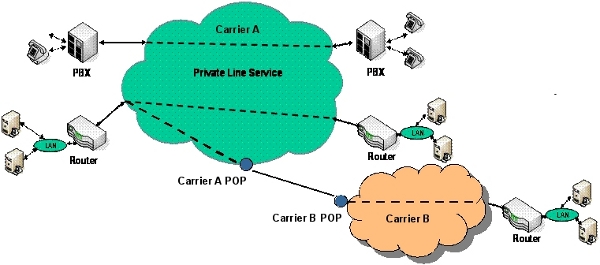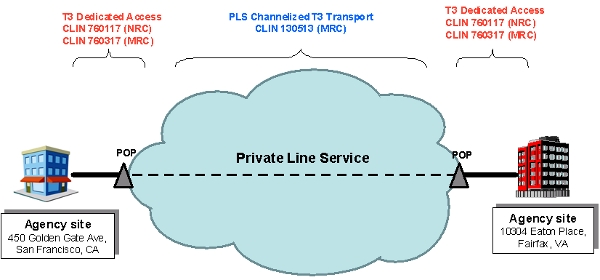PLS provides dedicated connectivity on a non-switched basis between two or more designated Service Delivery Points (SDPs) for voice, data, video, and multimedia service applications at Agency-specified bandwidths. Because PLS is a dedicated service, the maximum bandwidth purchased its always available on an end-to-end basis. Connectivity between end points is permanently established until an Agency requests a service modification, move, or disconnect.
PLS may be ordered as domestic (CONUS and OCONUS), or non-domestic service. PLS supports data rates from subrate-DS0 to T3 to SONET OC192 (including E1, E3 and OCONUS equivalent analog circuits). The range of line speeds, route diversity and reliability options provided by PLS allows an Agency to satisfy a wide variety of requirements for mission critical applications.
The figure below shows an illustrative PLS configuration. PLS provides dedicated connections that can interoperate with Government specified SDPs such as PBXs, Multiplexers, Routers, Video codecs, and Group 4 Faxes.
PLS, because it is an industry standard offering, allows for connection to and interoperation with all other networks, including other Networx Universal and Networx Enterprise carriers networks. The figure illustrates a link provided by carrier A and terminated on its POP. In the example, a second link is provided by Carrier B, including the access link between the two networks. Coordination across the carrier networks may be required for interoperability.

Illustrative PLS Configuration
PLS is a legacy service that was offered on FTS2001 contracts that supports the full range of technical capabilities available on commercial offerings. PLS provides transparency to any transmission protocol used and ensures visibility to all bit sequences transmitted through the SDP. Data rates supported by PLS include:
Non-domestic geographic coverage and offerings for PLS is specific to the different Networx service providers.
Mandatory PLS Features
Mandatory PLS features are detailed in the Networx Contracts Section C.2.5.1.2.1 and are briefly described below:
Allows interconnection of three or more subscribers premises as follows:
Provides different routes for PLS circuits based on the following arrangements:
Internal control (i.e., electronic flagging of routes) will be established for the PLS to prevent accidental dismantling of diversified/avoidance routes, especially during routine route optimization initiatives by the contractor.
PLS features that are optional to offer are:
Each Networx contractor may provide variations or alternatives to the offering and pricing for PLS. The specific details can be found within each Contractor's Networx contract files and pricing notes for PLS.
For more information on the general PLS specifications and requirements, please refer to Section C.2.5.1 of the Networx contract for technical specifications and Section B.2.5.1 for pricing.
PLS provides facilities for duplex (bi-directional) service between two or more specified end points; accordingly, PLS is priced without regard for direction of carried traffic. PLS is a legacy service that was offered on FTS2001 contracts under Dedicated Transport Service (DTS).
Price components required for full end-to-end service for Domestic and Non-Domestic PLS:
Note: The Networx Pricer automatically calculates the distance when given the originating and terminating locations.
Example 1: CONUS PLS Routine Level for T3 circuit

Each Networx contractor may provide variations or alternatives to the offering and pricing for PLS. The specific details can be found within each Contractors Networx contract files and pricing notes for PLS.
For more information on the general PLS specifications and requirements, please refer to Section C.2.5.1 of the Networx contract for technical specifications and Section B.2.5.1 for pricing.